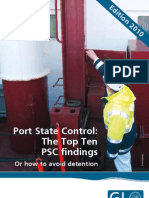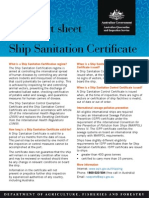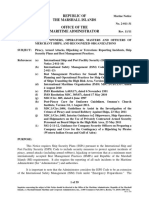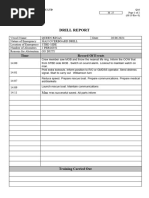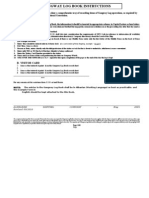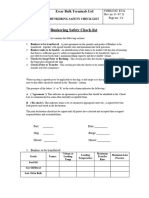Master Standing Orders: The Ch. Officer Is The Master's Representative and Responsible For
Master Standing Orders: The Ch. Officer Is The Master's Representative and Responsible For
Uploaded by
khoerotun nikmahCopyright:
Available Formats
Master Standing Orders: The Ch. Officer Is The Master's Representative and Responsible For
Master Standing Orders: The Ch. Officer Is The Master's Representative and Responsible For
Uploaded by
khoerotun nikmahOriginal Description:
Original Title
Copyright
Available Formats
Share this document
Did you find this document useful?
Is this content inappropriate?
Copyright:
Available Formats
Master Standing Orders: The Ch. Officer Is The Master's Representative and Responsible For
Master Standing Orders: The Ch. Officer Is The Master's Representative and Responsible For
Uploaded by
khoerotun nikmahCopyright:
Available Formats
MASTER STANDING ORDERS
The Ch. officer is the Master's representative and responsible for: -
1) Safety of the ship and the crew.
2) Compliance with International regulations relating to prevention of collision at sea.
3) Follow good seamanship practice.
4) Read, sign and follow the Master's night order notebook.
5) Calling the Master without hesitation
6) The officer shall without hesitation take the best possible action to avoid collision or
Grounding.
7) Continuing to perform his duties despite the presence of the Master on the Bridge, unless
the master has specifically and clearly declares that he resumed responsibility.
8) Not leaving the bridge unless he is properly relieved (No Exemption)
9) Maintaining the ordered courses (as per Passage Plan).
10) Always maintaining an effective lookout.
11) Always be aware of the nearby ships and take necessary anti-collision actions.
12) Maintaining a safe distance while steering the ship past other ships, obstacles, and fishing
nets.
13) Use all available electronic navigation systems, positions obtained shall be checked using
visual bearings.
14) Using the engines without hesitation, if necessary. (However, as far as possible, he shall
take all precautions before changing the engine speed and inform the Master.
15) Using the whistle when necessary.
16) Performing periodic inspections to ensure the following:
a. Correct course is maintained by the helmsman or the auto pilot. Error in the standard
and gyro compasses is measured at least once during the watch
b. Standard compass and gyro compass are compared often, and the repeater is
synchronized with the main compass
c. The auto pilot is changed over to manual mode and the ship is steered manually, at
least once during the watch
d. Navigation lights signal lights and other navigational equipment are functioning
normally.
17) Constantly listening to VHF Ch 16
18) Periodically observe the weather and sea conditions
.
19) Entering the required items in the ship's logbook, Radar logbook, and Compasses error
notebook, after completing his watch duty.
20) Adopting the necessary measures according. to the Special Navigation Procedures when
poor visibility occurs or ship is passing in narrow channels.
21) Observation of RADAR continuously, and shall always select the suitable range scale.
22) Starting RADAR plotting as early as possible.
23) Always using nautical charts of maximum scale and appropriate for the area of navigation.
24) Ensuring that members of his watch are fully capable of performing their duties
25) Ensuring that Bridge Watch keeping relief checklist is strictly followed.
Capt. Hany Monier
Subsea -88 Master
Signature:
WHEN TO CALL THE Master
The watch-keeping officer shall report to the Master promptly and receive instructions when the
conditions below occur or are predicted to occur.
1) If the Ch. Officer is in any doubt concerning the safety of the ship or crewmembers.
2) If the restricted visibility condition or an equivalent condition is predicted, or if the
visibility deteriorates to the level laid down in the Master's standing orders.
3) If there is uneasiness about the movements of another ship
4) If it is difficult to maintain course because of congested waters, weather or sea
conditions.
5) If there is doubt or uneasiness about the ship's position
6) If navigation marks or the shoreline cannot be identified or if the sounding results are
not as expected.
7) If the shoreline or the navigation marks are observed when not anticipated
8) If the ship has reached the point specified by the Master, or if the specified time has
elapsed.
9) If a trouble has occurred in the main engine, steering, gear or other important
machinery or equipment.
10) If an-abnormality is detected within or outside the ship
11) In the event of man-overboard or bodily injury to a person on board the ship
12) If a ship in distress or an unidentified ship such as a ship with refugees aboard has been
detected.
13) If a signal is received from another ship or from the shore. .
14) In other cases, when the watch-keeping officer cannot cope with the situation by
himself.
15) In the event of sighting Pirates or Pirates trying to board the vessel.
However (depending on the situation) if there is no time to wait the instructions from the
Master, the watch-keeping officer shall act without hesitation in an emergency. (e.g. using the
engine or making large course changes, if such action is considered to be in the best interests
of the safety of the ship).
Capt. Hany Monier Capt. Mohamed Ayman
Subsea -88 Master Chief Mate
Signature: Signature:
You might also like
- Supply Chain Management - Tata MotorDocument30 pagesSupply Chain Management - Tata MotorGajanan87% (15)
- Conan d20 1e - The Coming of Hanuman (MGP5598)Document15 pagesConan d20 1e - The Coming of Hanuman (MGP5598)weeble1000No ratings yet
- The Fathers of The Church A New Translation Volume 115 PDFDocument328 pagesThe Fathers of The Church A New Translation Volume 115 PDFRemon100% (2)
- PSC - How To Avoid Top 10 DetentionsDocument9 pagesPSC - How To Avoid Top 10 Detentionskurtmus100% (2)
- Code of Safe Working Practices for Merchant Seafarers: Consolidated edition (incorporating amendments 1-6)From EverandCode of Safe Working Practices for Merchant Seafarers: Consolidated edition (incorporating amendments 1-6)No ratings yet
- 1205.pdf (26 TO 46)Document21 pages1205.pdf (26 TO 46)PrakharNo ratings yet
- Garbage RecordDocument2 pagesGarbage RecordPKNo ratings yet
- Shortage Claim in TunisiaDocument4 pagesShortage Claim in Tunisiatanerkpt100% (1)
- Grain Cargo Care ChecklistDocument5 pagesGrain Cargo Care ChecklistEfren RojasNo ratings yet
- Ship Familiarization TrainingDocument7 pagesShip Familiarization Trainingryan abanicoNo ratings yet
- Hull PresentationDocument74 pagesHull PresentationManoj Varrier100% (2)
- Master'S Guide TO Compliance in Us Waters: 24-Hour Emergency Assistance +1 985 781 0804Document21 pagesMaster'S Guide TO Compliance in Us Waters: 24-Hour Emergency Assistance +1 985 781 0804Oleksandr Sinitsyn100% (1)
- Master Standing Order in PortDocument3 pagesMaster Standing Order in PortImroz Ahmed100% (1)
- Carriage of Grain Cargoes Nov 2015 LP Briefing PDFDocument8 pagesCarriage of Grain Cargoes Nov 2015 LP Briefing PDFAndriy100% (1)
- ID Code of Practise Towage Guidlines - 20140303 KWDocument12 pagesID Code of Practise Towage Guidlines - 20140303 KWhgmNo ratings yet
- Heavy Weather - Safety PrecautionsDocument8 pagesHeavy Weather - Safety PrecautionsAdil Ahmed100% (1)
- International Tonnage CertificateDocument2 pagesInternational Tonnage CertificateKarym DangerousNo ratings yet
- Guideline For Recording Ballast Water Record BookDocument9 pagesGuideline For Recording Ballast Water Record BookM G100% (1)
- Cargo Advice - Soya BeansDocument5 pagesCargo Advice - Soya Beansjim100% (1)
- Precautions For Loading Bulk GrainDocument6 pagesPrecautions For Loading Bulk GrainGaurav Harjai100% (1)
- 3 - Hand Over I.LEFTERDocument9 pages3 - Hand Over I.LEFTERalex.verdzadze98No ratings yet
- Asian VettingDocument13 pagesAsian Vettingkhaled1160No ratings yet
- Introduction To Isps Code: Bureau Veritas - Marine Division - Training SolutionsDocument1 pageIntroduction To Isps Code: Bureau Veritas - Marine Division - Training SolutionsRonald AranhaNo ratings yet
- Mariner Role in Collecting EvidenceDocument42 pagesMariner Role in Collecting EvidenceDilip de SilvaNo ratings yet
- Life Saving AppliancesDocument34 pagesLife Saving Applianceswan nazmi wan nasir100% (1)
- Ship Sanitation CertDocument1 pageShip Sanitation CertiomerkoNo ratings yet
- Sop-R-07 Safety Officers Monthly Inspection Report (VLCC, Product)Document10 pagesSop-R-07 Safety Officers Monthly Inspection Report (VLCC, Product)김순혁No ratings yet
- Piracy, Armed Attacks, Hijacking or Terrorism Reporting Incidents, Ship Security Plans and Best Management PracticesDocument59 pagesPiracy, Armed Attacks, Hijacking or Terrorism Reporting Incidents, Ship Security Plans and Best Management PracticesAlex100% (2)
- Appendix B - Master - Pilot Exchange of Essential Information On BoardingDocument1 pageAppendix B - Master - Pilot Exchange of Essential Information On BoardingViệt Dũng VũNo ratings yet
- Cargo DocumentsDocument15 pagesCargo DocumentsWallace Vale dos Santos100% (2)
- 10 Important Points To Remember During Mooring Operation On ShipsDocument2 pages10 Important Points To Remember During Mooring Operation On Shipswisnuker100% (2)
- Sanitation & Fumigation - AnswersDocument6 pagesSanitation & Fumigation - AnswersKirtishbose Chowdhury100% (1)
- KMSTC Instructor-Led Trainings Online Catalog 2024Document16 pagesKMSTC Instructor-Led Trainings Online Catalog 2024KMSTC AdminNo ratings yet
- Ship Risk Review 2021 Ver 6Document37 pagesShip Risk Review 2021 Ver 6KEISHIN ISO100% (1)
- International Ballast Water Management Cert ProvisionalDocument1 pageInternational Ballast Water Management Cert ProvisionalLegal EnvitecNo ratings yet
- Dry Docking - General Best PracticesDocument1 pageDry Docking - General Best Practicescoc verificationNo ratings yet
- Arrival ChecklistDocument1 pageArrival ChecklistFahreza MawlanaNo ratings yet
- Musters and Drills and On-Board Training & Instruction: Manx Shipping NoticeDocument7 pagesMusters and Drills and On-Board Training & Instruction: Manx Shipping NoticeAnkit Khokhar50% (2)
- 3.structural Damages During Cargo Operations DAY 3Document16 pages3.structural Damages During Cargo Operations DAY 3cicileana100% (1)
- Guidance For General Emergencies and Fire DrillsDocument13 pagesGuidance For General Emergencies and Fire Drillsrozita100% (1)
- Uk Pni Posters 1-111Document112 pagesUk Pni Posters 1-111Capt M J Thavapunithan John100% (7)
- Marine Emergency Procedures 2019Document20 pagesMarine Emergency Procedures 2019Jasonll100% (1)
- List of CertificatesDocument19 pagesList of CertificatesMin Soe100% (1)
- Condition Survey ReportDocument8 pagesCondition Survey ReportMastika GebrehiewotNo ratings yet
- Anchor Loss in Heavy WeatherDocument4 pagesAnchor Loss in Heavy WeatherJivanJyotiRout100% (1)
- Nav-00 PASSAGE PLANDocument25 pagesNav-00 PASSAGE PLANIrakli BakuridzeNo ratings yet
- Inspector Bulletin: Issue 4Document2 pagesInspector Bulletin: Issue 4Deepak100% (2)
- MOB DrillDocument2 pagesMOB DrillkaaabrioNo ratings yet
- Approaching Pilot Stations and Embarking and DisembarkingDocument35 pagesApproaching Pilot Stations and Embarking and DisembarkingKazem Love100% (1)
- Rank: Chief Officer Onboard IDSM Bulk/Log CarrierDocument4 pagesRank: Chief Officer Onboard IDSM Bulk/Log Carrierravishukla100% (1)
- Gangway Log Book Instructions - EnglishDocument2 pagesGangway Log Book Instructions - Englishjevgu100% (4)
- Unit IV. General Procedure of Preparing Ships For Entering Ports (Revisado)Document6 pagesUnit IV. General Procedure of Preparing Ships For Entering Ports (Revisado)Fernando CubidesNo ratings yet
- E23a ISGOTT Bunker ChklistDocument4 pagesE23a ISGOTT Bunker Chklistvic.barca2012100% (1)
- Capt. Malik Q&aDocument25 pagesCapt. Malik Q&aAbu Syeed Md. Aurangzeb Al Masum100% (2)
- Towage-ManualDocument14 pagesTowage-Manualahmed shreifNo ratings yet
- Yacht and Safety Briefing Checklist: Down Below On DeckDocument1 pageYacht and Safety Briefing Checklist: Down Below On DeckEky BagaskaraNo ratings yet
- Hypothermia: Photo by Belchonoc/depositphotosDocument3 pagesHypothermia: Photo by Belchonoc/depositphotosAsdNo ratings yet
- AMSA36Document66 pagesAMSA36Btwins123100% (2)
- Vetting PreparationDocument22 pagesVetting PreparationMykola KostiukNo ratings yet
- Abandon Ship Life BoatDocument5 pagesAbandon Ship Life BoatBunny DhindsaNo ratings yet
- Your Guide On Joining A Ship As 3rd MateDocument5 pagesYour Guide On Joining A Ship As 3rd MateDaniel Adeja III100% (1)
- Loaders AND Bobcats in General Are Used To Gather Bulk Cargo Residues in The Middle of Holds So That Unloading CAN Continue UninterruptedDocument22 pagesLoaders AND Bobcats in General Are Used To Gather Bulk Cargo Residues in The Middle of Holds So That Unloading CAN Continue Uninterruptedber100% (1)
- Docking:Undocking & Grounding:StrandingDocument12 pagesDocking:Undocking & Grounding:StrandingAkhil D SNo ratings yet
- MOOC Bill Amended (CA SB 520 April-May 2013)Document3 pagesMOOC Bill Amended (CA SB 520 April-May 2013)Chris NewfieldNo ratings yet
- A. Public Service Ministries/Agencies: VacanciesDocument20 pagesA. Public Service Ministries/Agencies: VacanciesvainuuvaalepuNo ratings yet
- English 4ap24 1trim2Document2 pagesEnglish 4ap24 1trim2khadoujsialiNo ratings yet
- ModifiedCRLA SchoolSummary v1Document55 pagesModifiedCRLA SchoolSummary v1SHIENABETH DACILLONo ratings yet
- KB Mart Floor PlanDocument16 pagesKB Mart Floor PlantgbstechNo ratings yet
- Detailed Lesson Plan in ABMDocument5 pagesDetailed Lesson Plan in ABMAnonymous QZsOxQsJNo ratings yet
- TimingDocument2 pagesTimingAbdul Moeed HasanNo ratings yet
- EPE Syllabus of Part-I (Common To All Engineering Disciplines)Document5 pagesEPE Syllabus of Part-I (Common To All Engineering Disciplines)Taimur AkhtarNo ratings yet
- Unit 5 Case Studies in Public Relations: StuctureDocument16 pagesUnit 5 Case Studies in Public Relations: StuctureManish pandeyNo ratings yet
- Writing Sample - Mozambique - Nick Branson PDFDocument4 pagesWriting Sample - Mozambique - Nick Branson PDFNick BransonNo ratings yet
- Final Royal EnfieldDocument66 pagesFinal Royal EnfieldVishal Mehta100% (1)
- Torts (Meshel Sem 2)Document25 pagesTorts (Meshel Sem 2)Jessie ChanNo ratings yet
- Jose Ramon CarcellerDocument49 pagesJose Ramon CarcellerCentSeringNo ratings yet
- Impact of CapitalDocument12 pagesImpact of CapitaluniyimeharrisonNo ratings yet
- TLE-Dressmaking: Module 1: MELC LO 1Document23 pagesTLE-Dressmaking: Module 1: MELC LO 1Shane Ann V. EugenioNo ratings yet
- Monetary Lent Topic7Document44 pagesMonetary Lent Topic7Sebastian MuñozNo ratings yet
- Paramahamsa Yogananda PDFDocument363 pagesParamahamsa Yogananda PDFking ofkingsNo ratings yet
- Javed Iqbal (1) - 1Document3 pagesJaved Iqbal (1) - 1Javed IqbalNo ratings yet
- Comacoe Corporate PresentationDocument19 pagesComacoe Corporate Presentationvivekb67No ratings yet
- Columbia Water and FEMA Come To Fundamental Agreement On Scope of Canal WorkDocument1 pageColumbia Water and FEMA Come To Fundamental Agreement On Scope of Canal WorkWIS Digital News StaffNo ratings yet
- Blue Book Resistance TablesDocument3 pagesBlue Book Resistance TablesLuuvan DongNo ratings yet
- कर्मकांड भास्करDocument390 pagesकर्मकांड भास्करSantosh JhaNo ratings yet
- R.A. No. 10173 DATA PRIVACY ACTDocument8 pagesR.A. No. 10173 DATA PRIVACY ACTKahayag 00No ratings yet
- The Role of The Public Accountant in The American Economy: Mcgraw-Hill/IrwinDocument37 pagesThe Role of The Public Accountant in The American Economy: Mcgraw-Hill/IrwinJana HallalNo ratings yet
- Mae Brussell QuotesDocument5 pagesMae Brussell QuotesIvana Vidanovic100% (1)
- On Brahmacharya, by Swami Nirmalananda SaraswatiDocument3 pagesOn Brahmacharya, by Swami Nirmalananda SaraswatimegamaverickNo ratings yet
- Conciliation ActDocument1 pageConciliation ActAmy CharlesNo ratings yet



